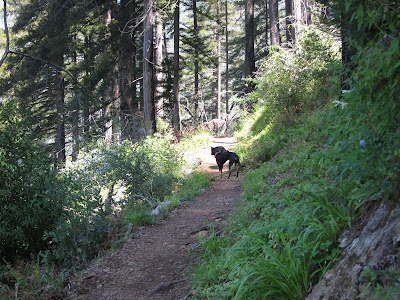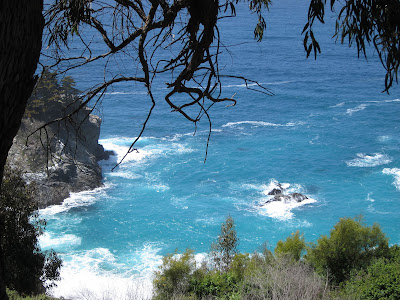I absolutely love camping and hiking in Big Sur. As the grand finale for this project, I went on a spring camping trip (April) in Big Sur. Located in Monterey County, Big Sur is one of this state's hidden gems. It is considered the northern tip that divides northern from southern California. Big Sur is well-known for it's coastal redwoods and breathtaking views of the Pacific.
Stellar's Jay (Cyanocitta stellara)
These intelligent birds lurk by campgrounds in Big Sur, looking for opportunities to raid the picnic basket. They are closely related to blue jays, although larger, with prominent black crowns on their heads. They are capable of a wide range of vocalizations from shrieks, to whistles, and repetitive clicks. The Stellar's Jay is native to the western part of the U.S. and is the only crested jay west of the Rockies. I thought they looked like prehistoric creatures, perhaps teradactyls?
--Poison oak (Toxicodendron diversilobum) is a real problem in Big Sur. Just having finished my last battle with it (the poison oak won), I came armed with "Technu", some strange-smelling liquid proposed to bind to the oils of the wretched plant and help wash them away. After hiking, I washed myself and the dogs off with the stuff, followed by a good dunking in the creek below our campground.
California poppy (Eschscholzia californica) is our state flower. This beautiful member of the poppy family is drought-resistant and a great candidate for the garden.
--Douglas Iris (Iris douglasiana) is a striking wildflower, common in the Pacific northwest, particularly in coastal regions.
--Western columbines (Aquilegia formosa) are more commonly seen a bit farther north, like in Oregon, and they are among my favorite flowers. I was delighted to discover a few them in Big Sur. This tough but showy wildflower attracts pollinators, like hummingbirds, and is also a great candidate for the garden. Apparently, the flower is sweet and edible, but the seeds are lethally poisonous.
--Gorgeous glimpse of far-away mountains through the tree-tops lining the trail.
-View of the trail (with Alan up ahead in the distance). We are surrounded by greenery. It is cool and misty in the shade but heating up quickly. The sun beats down on us when we step away from the trees and shines hotly and mercilessly. We scurry down the trail, seeking for the next patch of shade.
--a type of mustard? pretty, but most mustards are invasive.
--Wood sorrel (member of the Oxalis family) loves to grow at the base of the redwoods. They look like gigantic clover.
Branched Solomon's Seal (Smilacina racemosa). This is plant is a member of the lily family and likes to grow in dark, moist places, like at the bottom of the redwood forest floor, amongst the ferns.

--Travis, struggling to get up the steep hillside that leads from the trail down to the gorge. (Juneau, much nimbler, had no problem leaping up the mountain). Redwoods can grow on incredibly steep slopes.
--California Redwood Tree (Sequoia sempervirens)--our state tree. These trees are the largest trees on the planet and among the oldest as well. Some are thousands of years old. They create a special ecosystem along the coast of California, providing shade and moisture for a myriad of creatures that grow only in this habitat. Although this species of redwood cannot survive at colder temperatures, the Giant Redwoods (Sequoias) that live in the Sierras can, however. In addition, the Giant Redwoods can grow rapidly, for a tree--up to 10 feet a year. They also are some of the world's best photosynthesizing machines--providing clean oxygen in exchange for decreasing carbon dioxide, a greenhouse gas. These trees are being planted worldwide to help reduce global warming.
http://www.npr.org/templates/story/story.php?storyId=178365142
--Jepson's pea (Lathyrus jepsonii) is a wild pea that is native and limited (endemic) to California.
--Another stunning view of the northwestern side of the mountain (where we had hiked from)
--Indian paintbrush (Castilleja affinis) is a native wildflower of the western US, including California.
--Morning glory (Calystegia purpurata). These guys were everywhere, and I mistakenly thought they were invasive. Although there are some variants that are invasive, there are also many species that are indigenous to California.

--White morning glories dot the hillside.

----California lilac (Ceanothus thyrsiflorus)
--California lilac (Ceanothus thyrsiflorus) is a wild lilac, and this particular species is endemic to California. This evergreen shrub produces very fragrant, light purple blooms that attract pollinators, such as bees. Some of these bees must have built their hives close to the trail. I was chased several times down the trail by swarms of angrily buzzing bees.
--View of the trail up ahead, twisting and climbing upwards towards the heavens. In the background is the lush, northwest mountainside where we've just come from.
--Silver bush lupine (Lupinus albifrons) is a native wildflower of California. There are several species of lupine that grow wild along the state of California in spring. This is a hardy, drought-resistant plant that attracts pollinators and is naturally deer-resistant because of its bitter-tasting leaves. It is also poisonous to livestock because of the alkaloids it produces.
--Up on the exposed hillside, Jepsen's pea has progressed later in the life cycle, perhaps spurred by more warmth in this location. Shown here is one of several pea pods with lush, green, mountains, covered in redwoods in the background.
--Yellow sticky monkeyflower (Mimulus aurantiacus) is a gorgeous, yellow-flowering shrub with trumpet-shaped flowers that attracts hummingbirds. It is native to California.
--Queen Anne's Lace (Daucus carrot) is actually a type of wild carrot. I first remember encountering this wildflower in Virginia. I didn't realize its growth was so widespread across the nation. Not surprisingly, this is not native to California and is considered invasive.
--views of 2 sides of the mountain (top and bottom photos), one on each side of the river gorge below the trail. We were on the northwest side of the mountain, the lush green side (shown above). The southeast side of the mountain (2nd above photo) was very dry and reminded me of the differences between southern and northern California in a vivid depiction: chaparral vs. redwoods.
--Queen Anne's Lace, or wild carrot (Daucus carrota)--not native.
--Blue dicks (Dichelostemma caiptatum) are native California wildflowers that grows from a bulb. They are in the hyacinth family, and, similarly, bloom in early spring.

Starflower (Trientalis latifolia) is a native California wildflower. It prefers to grow in shaded, moist environments, like underneath a grove of redwoods.

--Dogs (Canis lupus) up ahead on the trail.
--The southern side of the hillsides looks dry and hot.

--Chalcedon Checkerspot Butterfly (Euphydryas chalcedoa) is native to California. He will turn into a butterfly with orange spots on a black background.

--Resting on the trail by the marker for the Ventana Wildnerness, Los Padres National Forest.

--Pine Rose (Rosa pinetorum) is a rare, native, wild rose that we saw in Big Sur.
--View of the creek down below.
--Lichen are composed of a two organisms, a fungus and a photosynthetic partner, a green algae, working together in a symbiotic relationship to form: lichen. Shown here is lichen growing on the north-facing side of the rock.
--A rare view of redwoods from the treetops.
--I love the crisscross patterns of the branches of these redwoods. I am inspired to try to paint this photograph with watercolor.
--Ferns are common on the bottom of the redwood forest floor. They like it moist and cool. Shown here may be a licorice fern (Polypodium glycyrrhiza).

--We didn't make it to Sykes hot springs. Apparently, the entire trail (to China Camp) is almost 27 miles. Good thing we only went 4 before turning around (8 total).
Back at Camp:
--The ocean is crystal clear and baby blue.


















































No comments:
Post a Comment